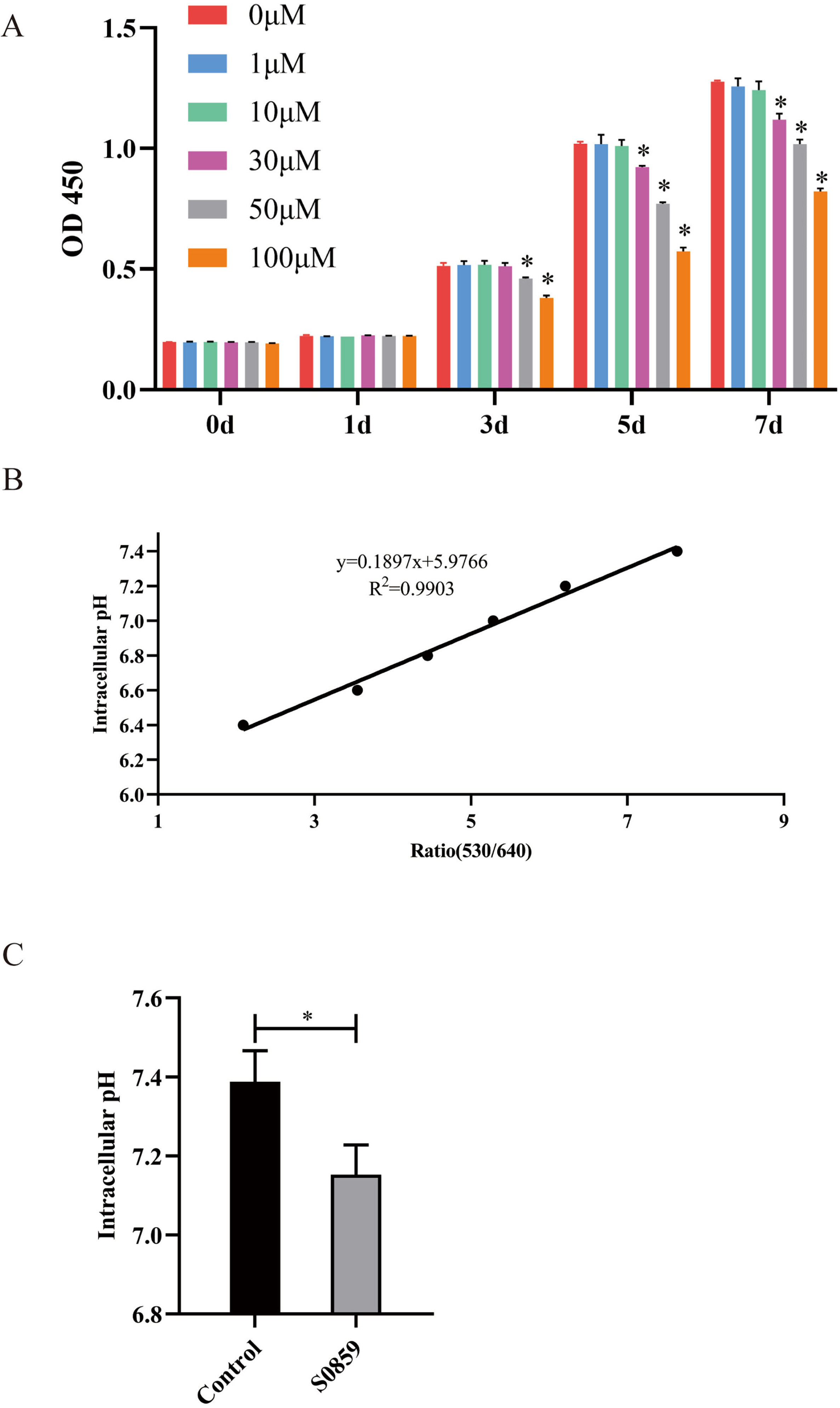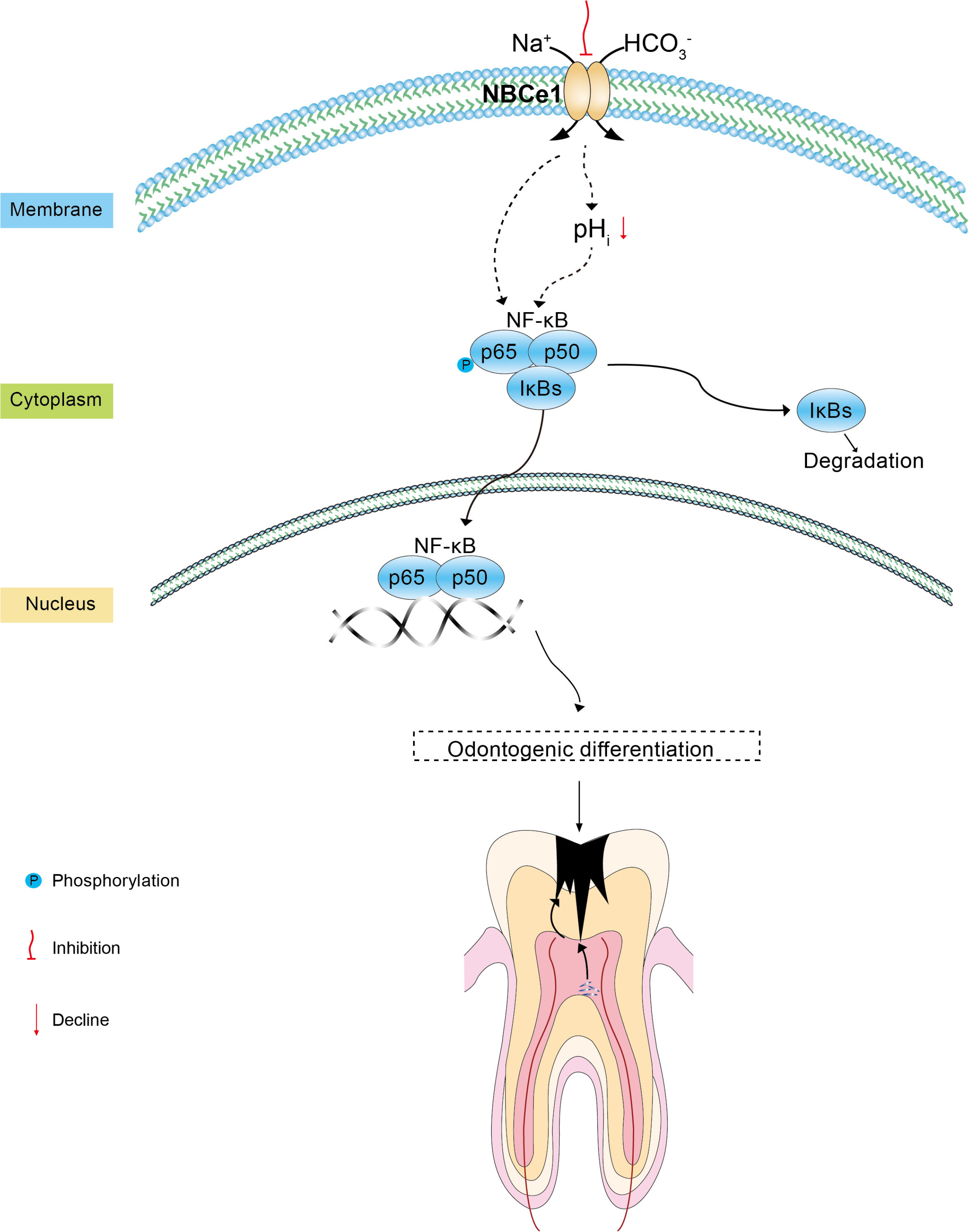Int J Stem Cells.
2022 Nov;15(4):384-394. 10.15283/ijsc21240.
NBCe1 Regulates Odontogenic Differentiation of Human Dental Pulp Stem Cells via NF-κB
- Affiliations
-
- 1Department of Stomatology, Huashan Hospital, Fudan University, Shanghai, China
- 2Department of Stomatology, Zhangye People’s Hospital Affiliated to Hexi University, Zhangye Gansu, China
- KMID: 2536208
- DOI: http://doi.org/10.15283/ijsc21240
Abstract
- Background and Objectives
Dental pulp stem cells (DPSCs) play an important role in the repair of tooth injuries. Electrogenic sodium bicarbonate cotransporter 1 (NBCe1) is a Na+ -coupled HCO3− transporter encoded by the solute carrier 4A4 (SLC4A4) gene and plays a crucial role in maintaining the pH of DPSCs. Our previous research confirmed that NBCe1 is highly expressed in odontoblasts during the development of the tooth germ. Therefore, in this study, we aimed to investigate the effect of NBCe1 on odontogenic differentiation of DPSCs and further clarify the underlying mechanisms.
Methods and Results
DPSCs were isolated and identified, and the selective NBCe1 inhibitor S0859 was used to treat DPSCs. We used a cell counting Kit-8 assay to detect cell proliferative ability, and intracellular pH was assessed using confocal microscopy. Odontogenic differentiation of DPSCs was analyzed using real-time PCR and Alizarin Red S staining, and the NF-κB pathway was assessed using western blotting. Our results indicated that 10 μM S0859 was the optimal concentration for DPSC induction. Intracellular pH was decreased upon treatment with S0859. The mRNA expressions of DSPP, DMP1, RUNX2, OCN, and OPN were upregulated in the NBCe1 inhibited group compared to the controls. Moreover, NBCe1 inhibition significantly activated the NF-κB pathway, and a NF-κB inhibitor reduced the effect of NBCe1 on DPSC differentiation.
Conclusions
NBCe1 inhibition significantly promotes odontogenic differentiation of DPSCs, and this process may be regulated by activating the NF-κB signaling pathway.
Figure
Reference
-
References
1. Arana-Chavez VE, Massa LF. 2004; Odontoblasts: the cells forming and maintaining dentine. Int J Biochem Cell Biol. 36:1367–1373. DOI: 10.1016/j.biocel.2004.01.006. PMID: 15147714. PMID: https://www.scopus.com/inward/record.uri?partnerID=HzOxMe3b&scp=2442586798&origin=inward.
Article2. Ma D, Gao J, Yue J, Yan W, Fang F, Wu B. 2012; Changes in proliferation and osteogenic differentiation of stem cells from deep caries in vitro. J Endod. 38:796–802. DOI: 10.1016/j.joen.2012.02.014. PMID: 22595115. PMID: https://www.scopus.com/inward/record.uri?partnerID=HzOxMe3b&scp=84861202351&origin=inward.
Article3. Sloan AJ, Waddington RJ. 2009; Dental pulp stem cells: what, where, how? Int J Paediatr Dent. 19:61–70. DOI: 10.1111/j.1365-263X.2008.00964.x. PMID: 19120509. PMID: https://www.scopus.com/inward/record.uri?partnerID=HzOxMe3b&scp=57849148621&origin=inward.
Article4. Hirose Y, Yamaguchi M, Kawabata S, Murakami M, Nakashima M, Gotoh M, Yamamoto T. 2016; Effects of extracellular pH on dental pulp cells in vitro. J Endod. 42:735–741. DOI: 10.1016/j.joen.2016.01.019. PMID: 26951958. PMID: https://www.scopus.com/inward/record.uri?partnerID=HzOxMe3b&scp=84959487035&origin=inward.5. Gao W, Zhang H, Chang G, Xie Z, Wang H, Ma L, Han Z, Li Q, Pang T. 2014; Decreased intracellular pH induced by cariporide differentially contributes to human umbilical cord-derived mesenchymal stem cells differentiation. Cell Physiol Biochem. 33:185–194. DOI: 10.1159/000356661. PMID: 24481225. PMID: https://www.scopus.com/inward/record.uri?partnerID=HzOxMe3b&scp=84893171367&origin=inward.
Article6. Hojo S, Komatsu M, Okuda R, Takahashi N, Yamada T. 1994; Acid profiles and pH of carious dentin in active and arrested lesions. J Dent Res. 73:1853–1857. DOI: 10.1177/00220345940730121001. PMID: 7814758. PMID: https://www.scopus.com/inward/record.uri?partnerID=HzOxMe3b&scp=0028704327&origin=inward.
Article7. Torabinejad M, Hong CU, McDonald F, Pitt Ford TR. 1995; Physical and chemical properties of a new root-end filling material. J Endod. 21:349–353. DOI: 10.1016/S0099-2399(06)80967-2. PMID: 7499973. PMID: https://www.scopus.com/inward/record.uri?partnerID=HzOxMe3b&scp=0029330853&origin=inward.
Article8. Casey JR, Grinstein S, Orlowski J. 2010; Sensors and regulators of intracellular pH. Nat Rev Mol Cell Biol. 11:50–61. DOI: 10.1038/nrm2820. PMID: 19997129. PMID: https://www.scopus.com/inward/record.uri?partnerID=HzOxMe3b&scp=72949121897&origin=inward.
Article9. Boron WF, Chen L, Parker MD. 2009; Modular structure of sodium-coupled bicarbonate transporters. J Exp Biol. 212(Pt 11):1697–1706. DOI: 10.1242/jeb.028563. PMID: 19448079. PMCID: PMC2683013. PMID: https://www.scopus.com/inward/record.uri?partnerID=HzOxMe3b&scp=66449097951&origin=inward.
Article10. Chen GS, Lee SP, Huang SF, Chao SC, Chang CY, Wu GJ, Li CH, Loh SH. 2018; Functional and molecular characterization of transmembrane intracellular pH regulators in human dental pulp stem cells. Arch Oral Biol. 90:19–26. DOI: 10.1016/j.archoralbio.2018.02.018. PMID: 29524788. PMID: https://www.scopus.com/inward/record.uri?partnerID=HzOxMe3b&scp=85042944907&origin=inward.
Article11. Yang J, Lu X, Liu S, Zhao S. 2020; The involvement of genes related to bile secretion pathway in rat tooth germ development. J Mol Histol. 51:99–107. DOI: 10.1007/s10735-020-09861-0. PMID: 32095972. PMID: https://www.scopus.com/inward/record.uri?partnerID=HzOxMe3b&scp=85081109604&origin=inward.
Article12. Ch'en FF, Villafuerte FC, Swietach P, Cobden PM, Vaughan-Jones RD. 2008; S0859, an N-cyanosulphonamide inhibitor of sodium-bicarbonate cotransport in the heart. Br J Pharmacol. 153:972–982. DOI: 10.1038/sj.bjp.0707667. PMID: 18204485. PMCID: PMC2267275. PMID: https://www.scopus.com/inward/record.uri?partnerID=HzOxMe3b&scp=40149083427&origin=inward.13. Li J, Ju Y, Liu S, Fu Y, Zhao S. 2021; Exosomes derived from lipopolysaccharide-preconditioned human dental pulp stem cells regulate Schwann cell migration and differentiation. Connect Tissue Res. 62:277–286. DOI: 10.1080/03008207.2019.1694010. PMID: 31769319. PMID: https://www.scopus.com/inward/record.uri?partnerID=HzOxMe3b&scp=85075743328&origin=inward.
Article14. Busa WB, Nuccitelli R. 1984; Metabolic regulation via intracellular pH. Am J Physiol. 246(4 Pt 2):R409–R438. DOI: 10.1152/ajpregu.1984.246.4.R409. PMID: 6326601. PMID: https://www.scopus.com/inward/record.uri?partnerID=HzOxMe3b&scp=0000672457&origin=inward.
Article15. Webb BA, Chimenti M, Jacobson MP, Barber DL. 2011; Dysregulated pH: a perfect storm for cancer progression. Nat Rev Cancer. 11:671–677. DOI: 10.1038/nrc3110. PMID: 21833026. PMID: https://www.scopus.com/inward/record.uri?partnerID=HzOxMe3b&scp=81155159685&origin=inward.
Article16. Charruyer A, Ghadially R. 2018; Influence of pH on skin stem cells and their differentiation. Curr Probl Dermatol. 54:71–78. DOI: 10.1159/000489520. PMID: 30130775. PMID: https://www.scopus.com/inward/record.uri?partnerID=HzOxMe3b&scp=85052236593&origin=inward.
Article17. Liu Y, Wang DK, Chen LM. 2012; The physiology of bicarbonate transporters in mammalian reproduction. Biol Reprod. 86:99. DOI: 10.1095/biolreprod.111.096826. PMID: 22262691. PMID: https://www.scopus.com/inward/record.uri?partnerID=HzOxMe3b&scp=84864020925&origin=inward.18. Lacruz RS, Nanci A, White SN, Wen X, Wang H, Zalzal SF, Luong VQ, Schuetter VL, Conti PS, Kurtz I, Paine ML. 2010; The sodium bicarbonate cotransporter (NBCe1) is essential for normal development of mouse dentition. J Biol Chem. 285:24432–24438. DOI: 10.1074/jbc.M110.115188. PMID: 20529845. PMCID: PMC2915679. PMID: https://www.scopus.com/inward/record.uri?partnerID=HzOxMe3b&scp=77955302357&origin=inward.
Article19. Ritchie H. 2018; The functional significance of dentin sialoprotein-phosphophoryn and dentin sialoprotein. Int J Oral Sci. 10:31. DOI: 10.1038/s41368-018-0035-9. PMID: 30393383. PMCID: PMC6215839. PMID: https://www.scopus.com/inward/record.uri?partnerID=HzOxMe3b&scp=85056277149&origin=inward.
Article20. Narayanan K, Ramachandran A, Hao J, He G, Park KW, Cho M, George A. 2003; Dual functional roles of dentin matrix protein 1. Implications in biomineralization and gene transcription by activation of intracellular Ca2+ store. J Biol Chem. 278:17500–17508. DOI: 10.1074/jbc.M212700200. PMID: 12615915. PMID: https://www.scopus.com/inward/record.uri?partnerID=HzOxMe3b&scp=0037931728&origin=inward.21. Gronthos S, Mankani M, Brahim J, Robey PG, Shi S. 2000; Postnatal human dental pulp stem cells (DPSCs) in vitro and in vivo. Proc Natl Acad Sci U S A. 97:13625–13630. DOI: 10.1073/pnas.240309797. PMID: 11087820. PMCID: PMC17626. PMID: https://www.scopus.com/inward/record.uri?partnerID=HzOxMe3b&scp=0034610376&origin=inward.22. Oeckinghaus A, Hayden MS, Ghosh S. 2011; Crosstalk in NF-κB signaling pathways. Nat Immunol. 12:695–708. DOI: 10.1038/ni.2065. PMID: 21772278. PMID: https://www.scopus.com/inward/record.uri?partnerID=HzOxMe3b&scp=80051987703&origin=inward.
Article23. He X, Jiang W, Luo Z, Qu T, Wang Z, Liu N, Zhang Y, Cooper PR, He W. 2017; IFN-γ regulates human dental pulp stem cells behavior via NF-κB and MAPK signaling. Sci Rep. 7:40681. DOI: 10.1038/srep40681. PMID: 28098169. PMCID: PMC5241669. PMID: https://www.scopus.com/inward/record.uri?partnerID=HzOxMe3b&scp=85009911180&origin=inward.
Article24. Sonoda S, Mei YF, Atsuta I, Danjo A, Yamaza H, Hama S, Nishida K, Tang R, Kyumoto-Nakamura Y, Uehara N, Kukita T, Nishimura F, Yamaza T. 2018; Exogenous nitric oxide stimulates the odontogenic differentiation of rat dental pulp stem cells. Sci Rep. 8:3419. DOI: 10.1038/s41598-018-21183-6. PMID: 29467418. PMCID: PMC5821879. PMID: https://www.scopus.com/inward/record.uri?partnerID=HzOxMe3b&scp=85042384991&origin=inward.
Article25. Feng X, Feng G, Xing J, Shen B, Li L, Tan W, Xu Y, Liu S, Liu H, Jiang J, Wu H, Tao T, Gu Z. 2013; TNF-α triggers osteogenic differentiation of human dental pulp stem cells via the NF-κB signalling pathway. Cell Biol Int. 37:1267–1275. DOI: 10.1002/cbin.10141. PMID: 23765556. PMID: https://www.scopus.com/inward/record.uri?partnerID=HzOxMe3b&scp=84888430727&origin=inward.
Article26. Wang Y, Yan M, Fan Z, Ma L, Yu Y, Yu J. 2014; Mineral trioxide aggregate enhances the odonto/osteogenic capacity of stem cells from inflammatory dental pulps via NF-κB pathway. Oral Dis. 20:650–658. DOI: 10.1111/odi.12183. PMID: 24102926. PMID: https://www.scopus.com/inward/record.uri?partnerID=HzOxMe3b&scp=84908323932&origin=inward.
Article27. Snead CM, Smith SM, Sadeghein N, Lacruz RS, Hu P, Kurtz I, Paine ML. 2011; Identification of a pH-responsive DNA region upstream of the transcription start site of human NBCe1-B. Eur J Oral Sci. 119(Suppl 1):136–141. DOI: 10.1111/j.1600-0722.2011.00867.x. PMID: 22243239. PMCID: PMC3374727. PMID: https://www.scopus.com/inward/record.uri?partnerID=HzOxMe3b&scp=84862920660&origin=inward.
Article28. Lu YC, Chen H, Fok KL, Tsang LL, Yu MK, Zhang XH, Chen J, Jiang X, Chung YW, Ma AC, Leung AY, Huang HF, Chan HC. 2012; CFTR mediates bicarbonate-dependent activation of miR-125b in preimplantation embryo development. Cell Res. 22:1453–1466. DOI: 10.1038/cr.2012.88. PMID: 22664907. PMCID: PMC3463266. PMID: https://www.scopus.com/inward/record.uri?partnerID=HzOxMe3b&scp=84867045888&origin=inward.
Article29. Luo AJ, Tan J, He LY, Jiang XZ, Jiang ZQ, Zeng Q, Yao K, Xue J. 2019; Suppression of Tescalcin inhibits growth and metastasis in renal cell carcinoma via downregulating NHE1 and NF-kB signaling. Exp Mol Pathol. 107:110–117. DOI: 10.1016/j.yexmp.2018.12.004. PMID: 30594602. PMID: https://www.scopus.com/inward/record.uri?partnerID=HzOxMe3b&scp=85061660883&origin=inward.
Article30. Bruck R, Schey R, Aeed H, Hochman A, Genina O, Pines M. 2004; A protective effect of pyrrolidine dithiocarbamate in a rat model of liver cirrhosis. Liver Int. 24:169–176. DOI: 10.1111/j.1478-3231.2004.00900.x. PMID: 15078482. PMID: https://www.scopus.com/inward/record.uri?partnerID=HzOxMe3b&scp=2342558077&origin=inward.
Article31. Wang M, Yang F, Qiu R, Zhu M, Zhang H, Xu W, Shen B, Zhu W. 2018; The role of mmu-miR-155-5p-NF-κB signaling in the education of bone marrow-derived mesenchymal stem cells by gastric cancer cells. Cancer Med. 7:856–868. DOI: 10.1002/cam4.1355. PMID: 29441735. PMCID: PMC5852371. PMID: https://www.scopus.com/inward/record.uri?partnerID=HzOxMe3b&scp=85042018182&origin=inward.
Article32. Jiang CY, Wang W, Tang JX, Yuan ZR. 2013; The adipocytokine resistin stimulates the production of proinflammatory cytokines TNF-α and IL-6 in pancreatic acinar cells via NF-κB activation. J Endocrinol Invest. 36:986–992. DOI: 10.3275/9002. PMID: 23765438. PMID: https://www.scopus.com/inward/record.uri?partnerID=HzOxMe3b&scp=84891707558&origin=inward.33. Park SY, Lee YJ, Cho EJ, Shin CY, Sohn UD. 2015; Intrinsic resistance triggered under acid loading within normal esophageal epithelial cells: NHE1- and ROS-mediated survival. J Cell Physiol. 230:1503–1514. DOI: 10.1002/jcp.24896. PMID: 25522216. PMID: https://www.scopus.com/inward/record.uri?partnerID=HzOxMe3b&scp=84925644928&origin=inward.
Article
- Full Text Links
- Actions
-
Cited
- CITED
-
- Close
- Share
- Similar articles
-
- Dlx3 and Dlx5 Inhibit Adipogenic Differentiation of Human Dental Pulp Stem Cells
- MiR-148a-3p Regulates the Invasion and Odontoblastic Differentiation of Human Dental Pulp Stem Cells via the Wnt1/β-Catenin Pathway
- Chios gum mastic enhance the proliferation and odontogenic differentiation of human dental pulp stem cells
- Galangin Regulates Mucin 5AC Gene Expression via the Nuclear Factor-κB Inhibitor α/Nuclear Factor-κB p65 Pathway in Human Airway Epithelial Cells
- Effects of CTHRC1 on odontogenic differentiation and angiogenesis in human dental pulp stem cells






